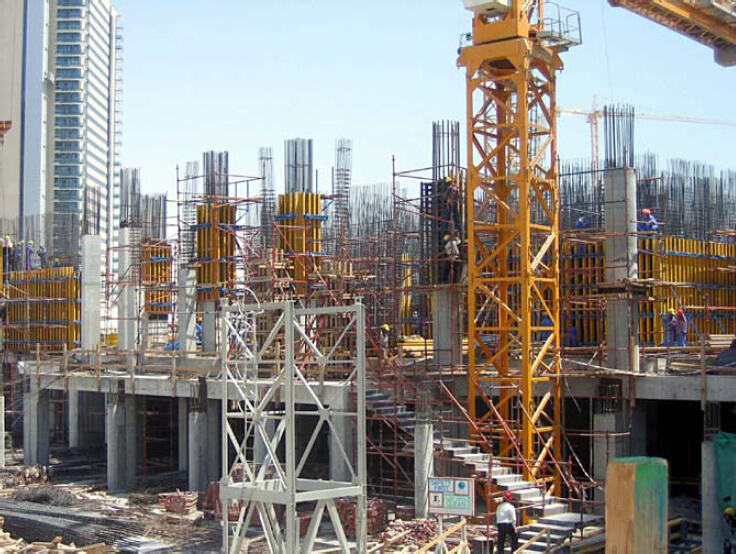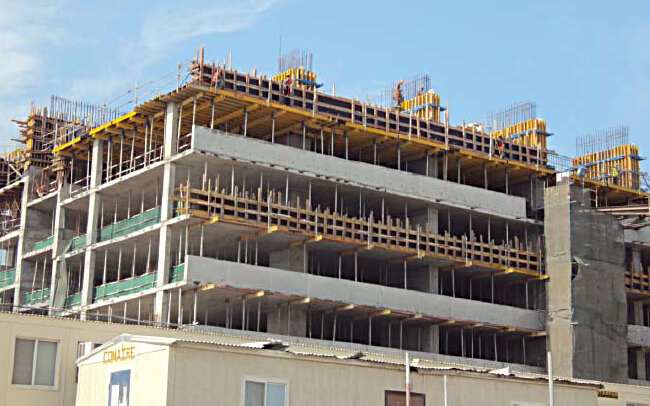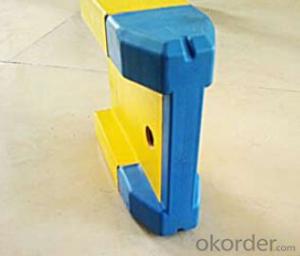Timber Beam Formwork for building construction
- Loading Port:
- Tianjin
- Payment Terms:
- TT OR LC
- Min Order Qty:
- 50 m²
- Supply Capability:
- 1000 m²/month
OKorder Service Pledge
Quality Product, Order Online Tracking, Timely Delivery
OKorder Financial Service
Credit Rating, Credit Services, Credit Purchasing
You Might Also Like
Characteristics:
◆ Standardized production lines.
Supply capability: 3000m/day, Lmax = 6600mm.
◆ Finger jointing of the flange and web, the strength of timber beam is highly improved.
Max. shearing force failure load:40KN
◆ Well treated to prevent from water penetration or erosion, so the service life maximally
extended.
Normally, CNBM timber beam H20 can be used for 4 to 5 years, the exact using time would
depend on maintenance & storage.
◆ Robust caps at the end of the girders protect against damages.


- Q:How does steel formwork affect the construction timeline?
- Steel formwork can significantly impact the construction timeline in a positive way. Due to its durability and strength, steel formwork offers faster installation and removal compared to traditional timber formwork. This expedites the construction process, allowing for quicker concrete pouring and curing times. Additionally, steel formwork provides better dimensional accuracy and reusability, reducing the time required for adjustments and replacements. Overall, the use of steel formwork can help streamline construction activities, leading to shorter project durations and improved efficiency.
- Q:Can steel formwork be used for both reinforced and non-reinforced concrete structures?
- Yes, steel formwork can be used for both reinforced and non-reinforced concrete structures. Steel formwork provides a strong and durable framework for concrete pouring and can be easily customized to accommodate different structural requirements, whether it involves reinforcing steel bars or not.
- Q:How does steel formwork handle different concrete pouring techniques?
- Steel formwork is highly versatile and can handle various concrete pouring techniques with ease. Its sturdy structure and durability enable it to withstand the pressure and weight of different concrete pouring methods, such as pouring by hand, pouring with a pump, or pouring using a crane. The steel formwork provides excellent support and stability, ensuring that the concrete maintains its desired shape and structure during the pouring process. Additionally, steel formwork can be easily adjusted and customized to accommodate different pouring techniques, making it a preferred choice for construction projects that require flexibility and adaptability.
- Q:Can steel formwork be used for airport construction projects?
- Yes, steel formwork can be used for airport construction projects. Steel formwork is known for its strength, durability, and ability to withstand heavy loads and harsh weather conditions, making it a suitable choice for large-scale projects such as airports. Additionally, steel formwork provides excellent quality and precision in concrete construction, ensuring the required high standards for airport infrastructure.
- Q:Can steel formwork be used for staircase construction?
- Yes, steel formwork can be used for staircase construction. Steel formwork is a versatile and durable material that is commonly used in construction projects, including staircase construction. It provides a strong and stable structure for pouring concrete and ensures precise and accurate shaping of the staircase. Additionally, steel formwork is reusable, making it a cost-effective choice for repetitive construction processes like staircase construction. It also offers flexibility in design, allowing for the creation of various staircase shapes and sizes. Overall, steel formwork is a suitable choice for staircase construction due to its strength, durability, reusability, and design flexibility.
- Q:What are the common problems encountered with steel formwork?
- There are several common problems that can be encountered with steel formwork in construction projects. One of the main issues is corrosion. Steel formwork is prone to rust and deterioration when exposed to moisture or harsh environments. This can weaken the structure and compromise its integrity, leading to potential safety hazards. Another problem is the difficulty in handling and transporting steel formwork due to its heavy weight. This can make it challenging to maneuver and assemble on-site, especially in tight spaces or high-rise buildings. The weight of the steel formwork also increases the labor and equipment costs required for installation. In addition, steel formwork may require regular maintenance to prevent damage and ensure its longevity. This includes cleaning, repairing any corrosion or dents, and applying protective coatings to prevent further deterioration. This maintenance can be time-consuming and costly, adding to the overall project expenses. Furthermore, steel formwork may not be suitable for certain construction applications. It is not easily customizable or adjustable compared to other formwork materials, such as timber or plastic. This can limit its flexibility in accommodating unique shapes or designs. Lastly, the cost of steel formwork is generally higher compared to other formwork materials. This can impact the project budget, especially for smaller or budget-constrained construction projects. Overall, while steel formwork offers durability and strength, it is important to be aware of these common problems and take necessary precautions to mitigate them. Regular maintenance, proper handling, and considering alternative formwork materials when appropriate can help address these issues and ensure a successful construction project.
- Q:Can steel formwork be used for both single-sided and double-sided forming?
- Yes, steel formwork can be used for both single-sided and double-sided forming. Steel formwork is known for its strength and durability, making it suitable for various construction applications. When used for single-sided forming, the steel panels are secured against a solid surface or existing structure, acting as a barrier to hold the concrete in place until it sets. On the other hand, for double-sided forming, steel formwork panels are used on both sides of the concrete pour, creating a mold that holds the concrete in place and provides a smooth finish on both sides of the structure. The versatility of steel formwork allows it to be used in a wide range of construction projects, including walls, columns, beams, slabs, and more.
- Q:Can steel formwork be used for high-rise buildings?
- Indeed, high-rise buildings can indeed utilize steel formwork. Renowned for its resilience, robustness, and capacity to withstand immense concrete pressures, steel formwork proves itself well-suited for erecting towering structures like high-rise buildings. Specially engineered steel formwork systems serve the purpose of furnishing stability and bolstering during construction, guaranteeing precise molding and appropriate curing of the concrete. Furthermore, the ease with which steel formwork can be assembled and dismantled ensures expedient construction while accommodating various project specifications. All in all, steel formwork emerges as a dependable and frequently employed approach to high-rise building construction.
- Q:How does steel formwork contribute to the fire resistance of the structure?
- Steel formwork, also known as steel molds or frames, significantly contributes to the fire resistance of a structure in several ways. First and foremost, steel is an inherently fire-resistant material. It has a high melting point and does not combust easily, making it an ideal choice for formwork in fire-prone areas. When steel formwork is used in construction, it provides a strong and rigid structure that helps maintain the integrity of the building during a fire. The steel molds hold the concrete in place, preventing it from collapsing or disintegrating when exposed to high temperatures. This structural stability allows firefighters to safely enter the building and extinguish the fire without the fear of sudden structural failure. Moreover, steel formwork can act as a heat sink during a fire. The high thermal conductivity of steel allows it to absorb and dissipate heat quickly, minimizing the spread of fire and reducing the overall temperature within the structure. By absorbing heat, steel formwork helps delay the point at which the concrete begins to spall or crack, thereby maintaining the structural integrity of the building for a longer period. Additionally, steel formwork is often designed with appropriate fire-resistant coatings or insulation materials. These coatings provide an extra layer of protection against the heat, flames, and smoke generated during a fire. They can also help in preventing or slowing down the transfer of heat to the concrete, further enhancing the fire resistance of the structure. Overall, the use of steel formwork in construction significantly contributes to the fire resistance of a building by providing structural stability, acting as a heat sink, and incorporating fire-resistant coatings or insulation materials. By utilizing steel molds, architects and engineers can ensure the safety and durability of the structure, even in the event of a fire.
- Q:What are the different types of steel formwork systems available in the market?
- There are several different types of steel formwork systems available in the market, including traditional steel formwork, modular steel formwork, and panelized steel formwork. Traditional steel formwork consists of steel plates or frames that are assembled on-site to create the desired formwork shape. Modular steel formwork is pre-engineered and consists of standardized panels that can be easily assembled and reused. Panelized steel formwork is similar to modular steel formwork but consists of large panels that are interconnected to create the desired formwork shape.
1. Manufacturer Overview |
|
|---|---|
| Location | |
| Year Established | |
| Annual Output Value | |
| Main Markets | |
| Company Certifications | |
2. Manufacturer Certificates |
|
|---|---|
| a) Certification Name | |
| Range | |
| Reference | |
| Validity Period | |
3. Manufacturer Capability |
|
|---|---|
| a)Trade Capacity | |
| Nearest Port | |
| Export Percentage | |
| No.of Employees in Trade Department | |
| Language Spoken: | |
| b)Factory Information | |
| Factory Size: | |
| No. of Production Lines | |
| Contract Manufacturing | |
| Product Price Range | |
Send your message to us
Timber Beam Formwork for building construction
- Loading Port:
- Tianjin
- Payment Terms:
- TT OR LC
- Min Order Qty:
- 50 m²
- Supply Capability:
- 1000 m²/month
OKorder Service Pledge
Quality Product, Order Online Tracking, Timely Delivery
OKorder Financial Service
Credit Rating, Credit Services, Credit Purchasing
Similar products
New products
Hot products
Hot Searches
























